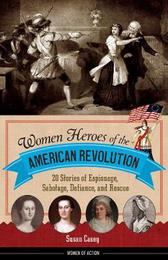
|
Women Heroes of the American Revolution: 20 Stories of Espionage, Sabotage, Defiance, and Rescue
Paperback / softback
Main Details
| Title |
Women Heroes of the American Revolution: 20 Stories of Espionage, Sabotage, Defiance, and Rescue
|
| Authors and Contributors |
By (author) Susan Casey
|
| Series | Women of Action |
|---|
| Physical Properties |
| Format:Paperback / softback | | Pages:240 | | Dimensions(mm): Height 215,Width 139 |
|
| ISBN/Barcode |
9781613738313
|
| Classifications | Dewey:973.3082 |
|---|
| Audience | |
|---|
|
Publishing Details |
| Publisher |
Chicago Review Press
|
| Imprint |
Chicago Review Press
|
| Publication Date |
1 July 2017 |
| Publication Country |
United States
|
Description
Every schoolchild knows about Paul Revere's 20-mile ride to warn that the British were coming. Far fewer know that 16-year-old Sybil Ludington rode twice as far to help her father, Colonel Ludington, muster his scattered troops to fight a marauding enemy. Few know about Martha Bratton, who blew up a supply of gunpowder to keep it from approaching British troops and boldly claimed, "It was I who did it!" Susan Casey gives Ludington, Bratton, and 18 other remarkable girls and women of the Revolution the spotlight they deserve in this lively collection of biographical profiles. Drawing on interviews with historians and descendants as well as primary source material, this is an invaluable resource for any student's or history buff's bookshelf.
Author Biography
Susan Casey is the author of Kids Inventing! and Women Invent! and a journalist whose work has appeared in Fast Company, Women's Sports, the Los Angeles Times, and the San Francisco Chronicle, among other publications. She lives in Los Angeles.
Reviews"A fine, useful resource for students of American history." -- Booklist "This well-researched book sheds light on lesser known women of this period and is an excellent way to incorporate diversity into the curriculum." -- School Library Journal "Helpful, sometimes-humorous touches include explanations of archaic activities, lifestyles and social mores; well-documented primary and secondary sources; and clear instructions on how to read a political cartoon. A good starting point for further research." -- Kirkus Reviews
|